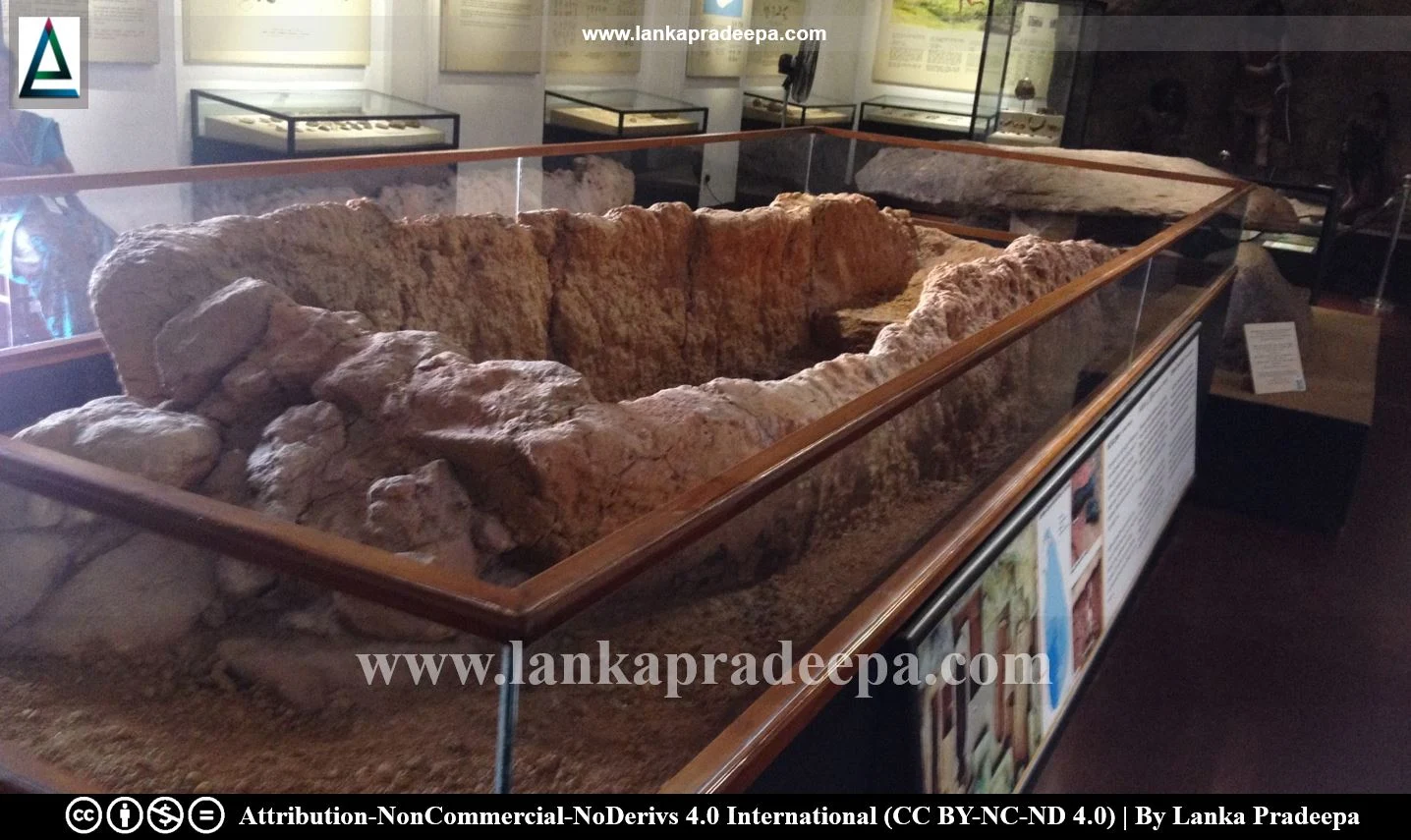
Pre & Proto-historic Burials in Sri Lanka mainly belong to two funerary traditions, viz: clay-chambered burial and megalithic burial tradition (Dissanayake et al., 2021). Studies on these burials were begun in the country with the discovery of urn burials in 1887 by H. Nevil and Gurugalhinna tombs by R.W. Lever in 1889.
Several pre & proto-historic burials with radiocarbon dates are listed below;
-
1) Beragala Kalupahanawatta [(2,400 B.C.) Jayaratne & Jayaratne, 2018]
3) Ranchamadama [(1,359 B.C.) Jayaratne & Jayaratne, 2018]
5) Ibbankatuwa [(750-400 B.C.) Saldin et al., 2007]
7) Andarawewa [(507-429 B.C.) Young et al., 2020] 9) Nikawalamulla [(384-170 B.C.) Jayaratne & Jayaratne, 2018]
11) Pinwewa Galsohon Kanatta (112 B.C.)
-
2)Haldummulla [(1,750 B.C.) Jayaratne & Jayaratne, 2018]
4) Kok Abe [(790 B.C.-125 A.D.) Mendis, 2017]
6) Ihala Kalawellaulpota (520 B.C.)
8) Thammennagodella [(490 B.C.) Mendis, 2017]
10) Kalotuwawa [(135-51 B.C.) Perera, 2010]
12)Dummalasuriya [(86-345 A.D.) Jayaratne & Jayaratne, 2018]
Types of burials
Researchers have documented several different types of burials discovered across the country.
Urn Burials

In this burial method, the bone remains of the deceased such as the head, arms and legs (not the entire skeleton) are placed inside an urn and buried underground by covering its mouth with a capstone (Mendis, 2016). Usually, urns are enormous in size and made of clay. Sometimes, several other clay vessels containing ritual offerings, ornaments and tools are also placed along with the body remains (Kelum & Wickremasinghe, 2014). Most of the clay urns found on the island are red (RW) and brown (BRW) in colour (Bandara, 1997).
Burials belonging to this type have been found in Anaikkoddai, Andarawewa, Galatara, Ibbankatuwa, Karabankulama, Kok Abe, Makewita, Pomparippu, Thammannagodella, Thekkama.
Cist Burials
Cist burials are frequently found in the megalithic tradition. They are widely scattered in the dry zone and a smaller number has been recorded in the intermediate and wet zones. Many burial sites of this kind have been identified along several river basins in the dry zone including the Yan Oya, Malvathu Oya, Kala Oya and Mee Oya (Dissanayake et al., 2021).
In this method, the remains of the deceased (vessels containing ashes/bone fragments and other belongings used by the individual) are placed within the cist made of four stone slabs kept to form a rectangular space (Mendis, 2016). A flat slab of rock is then placed over the burial.

Burials of this type have been recorded at Alapathwewa, Aluthbombuva, Anaikkoddai, Andarawewa, Athabendiwewa, Bandaraduwa, Berawayagala, Dikwewa, Divulwewa, Egollakadawala, Galadakatuwa, Galathara, Galgamuwa, Galsohon Kanatta, Galwela, Gurugalhinna, Divulwewa, Havanvela, Ibbankatuwa, Kadiraweli, Kalpe, Kanagaha-ulpota, Karuwalagaswewa, Kirimetiyawa, Kok Abe, Mahagalwewa, Malporuwala, Mamaduwa, Mawathawewa, Maradanmaduwa, Mohapotana, Nethugollawa, Oluwewa, Padarellawa, Palippothana, Panketiyawa, Parangiyawadiya, Pinwewa, Polpitigama, Rambewa, Thambarawa, Thammannagodalla, Vahalkada, Vattakawadiya and Yatigalpottha.
Dolmenoid Cists
A burial chamber made of stones both for the sides and the cap. A few of these have been recorded at Galadakatuwa, Padavigampola and Vahalkada.
Earthen Canoe Burials
These burials are unique to Sri Lanka and the first one of this kind was reported in 1952 at a place at Bandattara in Matara by P.E.P. Deraniyagala (Jayaratne & Jayaratne, 2018; Wanninayake, 2016). The majority of sites are recorded from the wet and intermediate zones and compared to the other types of burials, clay canoe burial sites are relatively low in numbers (Jayaratne & Jayaratne, 2018).
In this burial method, canoe-like burials are made using clay. Usually, one of the canoes served as a crematorium where the body was burnt and the remains (ashes or skeletal remains) were then moved into another canoe. Finally, the chamber of the canoe is filled and covered with a layer of burnt clay lumps. Burial sites with earthen canoes have been discovered from Attanagalla, Bandattara, Devalapola, Dummalasuriya Haldummulla, Ibbankatuwa, Kalotuwawa, Kalupahanawatta, Mahalenama, Nikawalamulla, Ranchamadama.
Cairn burials
A cairn is a man-made pile of stones raised to mark a burial site. "Cairn circle burials" in which one or two stone circles are placed around the tomb have been found at several places such as Gorakapelessa, Kalanai bridge, Koviltenna, Mamaduwa, Moragodayaya, Nilagiriseya, Oluwewa, Paluketiwewa, Seetiwatta.
"Cairn mound/heap burials" in which stones are placed over the remains as a heap have been recorded at Alapatwewa, Gorakapelessa, Habarattawala, Kanagaha-ulpota, Kok Abe, Mamaduwa, Moragodayaya, Nikawewa, Oluwewa and Velanwita.
References
1) Bandara, Y.K.T., 1997. Classification of Pottery From Pinwewa. pp.1-15.
2) Dissanayake, N.H., Siriwardana, T.M., Jayasekara, I.R. and Mendis, D.T., 2021. Cup Marks in the Capstones of Palippothana Mortuary Complex. Rajarata University of Sri Lanka. pp.225-235.
3) Jayaratne, D.K.; Jayaratne, J.D.K., 2018. An ancient clay canoe burial tradition in Sri Lanka. International Conference on the Humanities and the Social Sciences (ICHSS).pp.285-289.
4) Kelum, M.A., Wickremasinghe, H., 2014. Action Plan for Conservation & Sustainable Use of Palaeobiodiversity in Sri Lanka. Biodiversity Secretariat, Ministry of Environment & Renewable Energy. p.28.
5) Mendis, T., 2016. මධ්ය යාන්ඔය නිම්නයේ පූර්ව ඓතිහාසික අවධියේ සුසාන ආශ්රිත වාස්තුවිද්යාව. University of Rajarata. pp.150-153.
6) Mendis, T., 2017. New Light to the Proto Historic Iron Age in Sri Lanka. The Journal of Archaeology & Heritage Studies: Volume-4, Number-3. pp.49-70.
7) Perera, H.N., 2010. Early Historical Clay Cist Graves at Kalotuwawa (Sri Lanka). Zeitschrift für Archäologie Außereuropäischer Kulturen. pp.67-72.
8) Saldin, M., Adikari, G. and Gunawardhana, P., 2007. Havanvela: a Megalithic Cist Burial Site from the Matale District. Proceeding of the Annual Research Symposium. Faculty of Graduate Studies, University of Kelaniya. p.77.
9) Wanninayake, A., 2016. A Protohistoric Burial Tradition in Sri Lanka. Ancient Ceylon No. 25: Archaeology Survey Department. pp.200-222.
10) Young, S.M., Mendis, D.T. and Ishiga, H., 2020. New Perception to Proto History Burial Site in Andarawewa An Archaeological and Geochemical Prospection. Journal of Archaeology, Tourism & Anthropology, Department of Archaeology, University of Kelaniya. Volume I, Issue I. pp.78-92.

